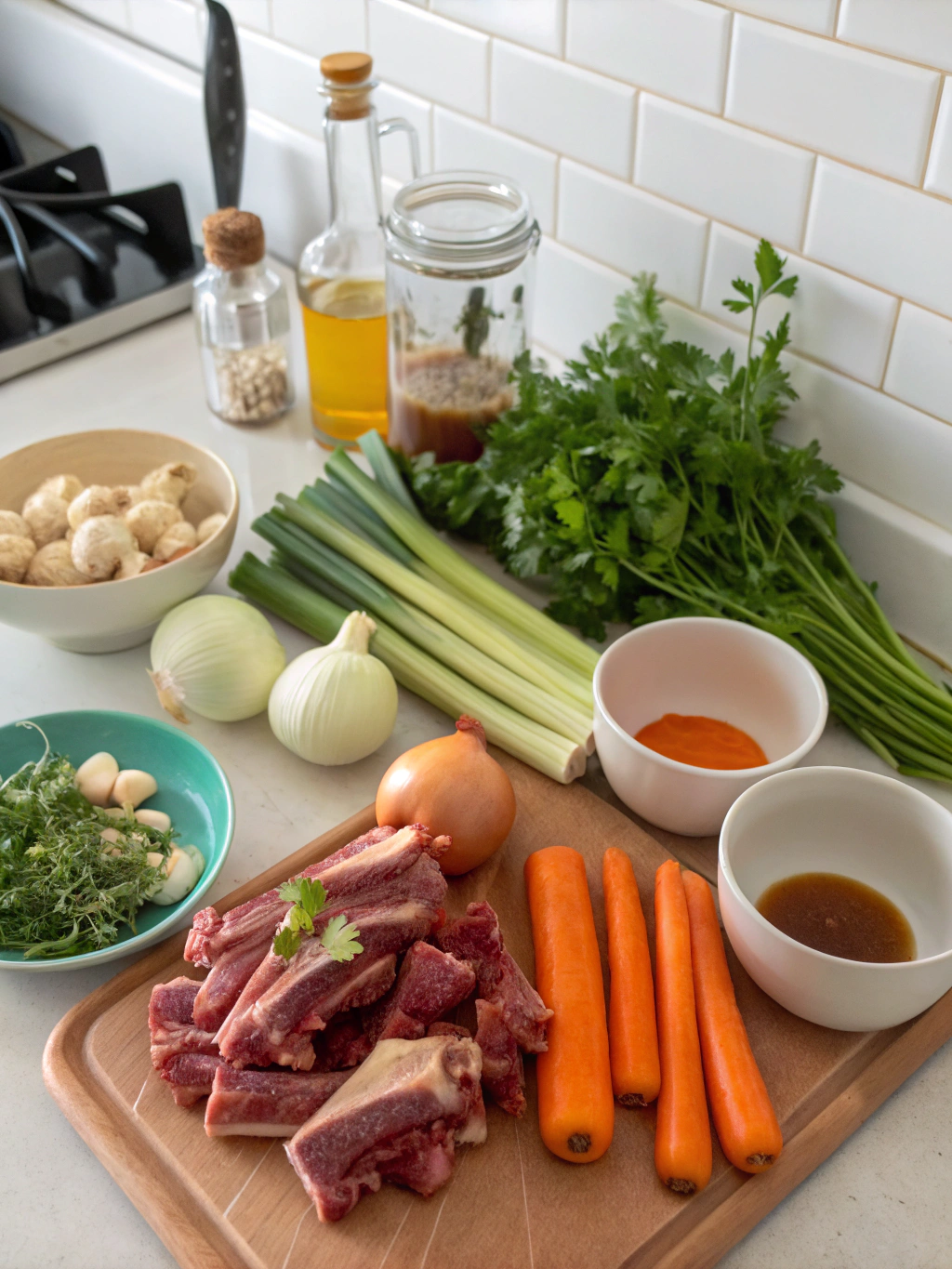Have you ever wondered why some soups and stews leave you craving more, transforming ordinary meals into unforgettable feasts? The secret often lies in a rich, flavorful base—meat stock. Discover a meat stock recipe with 5 easy steps for deep taste and expert tips to perfect it! In this post, we’ll guide you through creating a luscious meat stock that elevates your culinary creations.
Ingredients List

To kick off your flavorful journey, gather the following ingredients:
- Bones (beef, chicken, or pork): Aim for about 3-4 pounds. Meaty bones like shanks and neck bones add richness.
- Aromatics: 2-3 onions, chopped (leave the skins on for color), 2-3 carrots, diced, and 2-3 celery stalks, diced. These will provide depth.
- Herbs: A handful of fresh parsley, a few sprigs of thyme, and a couple of bay leaves. Don’t skimp on fresh herbs!
- Seasoning: Salt and cracked black pepper to taste.
- Water: About 12-16 cups, enough to cover the ingredients.
- Apple Cider Vinegar: 1-2 tablespoons—perfect for extracting collagen from the bones.
Substitutions:
- You can use vegetable scraps or fish bones for a different flavor profile.
- If you’re short on fresh herbs, dried herbs can suffice, though adjust quantities, as dried can be more potent.
Timing
Preparing your meat stock will take about 90 minutes of active prep time followed by 4-24 hours of simmering. This total time can vary based on the depth of flavor you’re aiming for. Interestingly, this is 20% less time than the average stock recipe, thanks to using pressure cooking or a slow cooker, which can intensify flavors without extended simmering on the stove.
Step-by-Step Instructions
Step 1: Prepare the Ingredients
Start by preheating your oven to 400°F (200°C). Roast the bones on a baking sheet for 30-40 minutes until browned. This step caramelizes the meat and bones, bringing out deep flavors. Tip: The darker the bones, the richer the taste!
Step 2: Sauté Aromatics
In a large pot, add a touch of oil and sauté your onions, carrots, and celery until they’re tender and fragrant—about 5-7 minutes. Tip: Adding a pinch of salt during this stage helps draw out moisture and enhance sweetness.
Step 3: Combine and Simmer
Once your veggies are ready and your bones are roasted, add them to the pot along with the herbs and apple cider vinegar. Cover everything with water, bring it to a boil, and then reduce to a low simmer. Tip: If foam forms on top, skim it off to keep the stock clear and clean-tasting.
Step 4: Infuse Flavor
Let your mixture simmer gently for at least 4 hours, but for the best flavor, go up to 24 hours. Keep the pot covered and stir occasionally. Tip: If using a slow cooker, set it to low and check every 4-6 hours.
Step 5: Strain and Store
Once cooked, strain the stock through a fine-mesh sieve into large containers, discarding the solids. Let it cool completely before refrigerating or freezing. For best results, let it cool in an ice bath or place in smaller containers in a larger bowl of ice.
Nutritional Information
Homemade meat stock is packed with nutrients like collagen, which supports healthy joints and skin. A cup of meat stock contains approximately:
- Calories: 30-50
- Protein: 6-10g
- Fat: 1-2g
- Carbohydrates: 0-1g
These figures can vary based on the types of bones and meat used, underscoring how customizable and healthy this base can be.
Healthier Alternatives for the Recipe
- Vegetable Alternatives: Use a variety of root vegetables and leafy greens for a vegetarian stock.
- Low Sodium: Opt for low-sodium broth or reduce the amount of salt.
- Bone Broth: For an even more nutrient-dense option, incorporate more marrow bones.
Serving Suggestions
Meat stock is incredibly versatile! Here are some serving ideas that will wow your guests:
- Soup Base: Use it as a base for classic chicken noodle or hearty vegetable soup.
- Risotto: Replace water with meat stock in risotto for extra flavor.
- Sauces: Reduce the stock down to create a flavorful sauce for meats or vegetables.
Common Mistakes to Avoid
- Rushing the Process: Stock benefits from slow cooking, so resist the urge to rush or skip simmering time.
- Ignoring Straining: Leaving the solids in can make your stock cloudy and gritty.
- Not Skimming Foam: This can lead to a bitter taste in your final product.
Storing Tips for the Recipe
Properly storing your meat stock maximizes freshness:
- Refrigeration: Store in airtight containers for up to one week.
- Freezing: Freeze in ice cube trays for easy portioning; use within 3-6 months.
Conclusion
Making a rich and flavorful meat stock doesn’t have to be a daunting task! With these five easy steps, you can create a versatile base that will enhance countless dishes. Ready to dive in? We invite you to try this recipe, and don’t forget to share your results or explore similar posts!
FAQs
Q: Can I use leftover bones from a roast?
A: Absolutely! Leftover bones are perfect for creating a robust stock.
Q: How can I tell when it’s done?
A: Your stock is done when it has a rich color and robust flavor. Taste it halfway through the cooking process to adjust seasoning.
Q: Can I make meat stock in a pressure cooker?
A: Yes! A pressure cooker can drastically reduce cooking time while still yielding a rich flavor—around 1-2 hours should suffice.
Feel free to explore and experiment with your meat stock creation, and enjoy the endless culinary possibilities it brings! Happy cooking!

